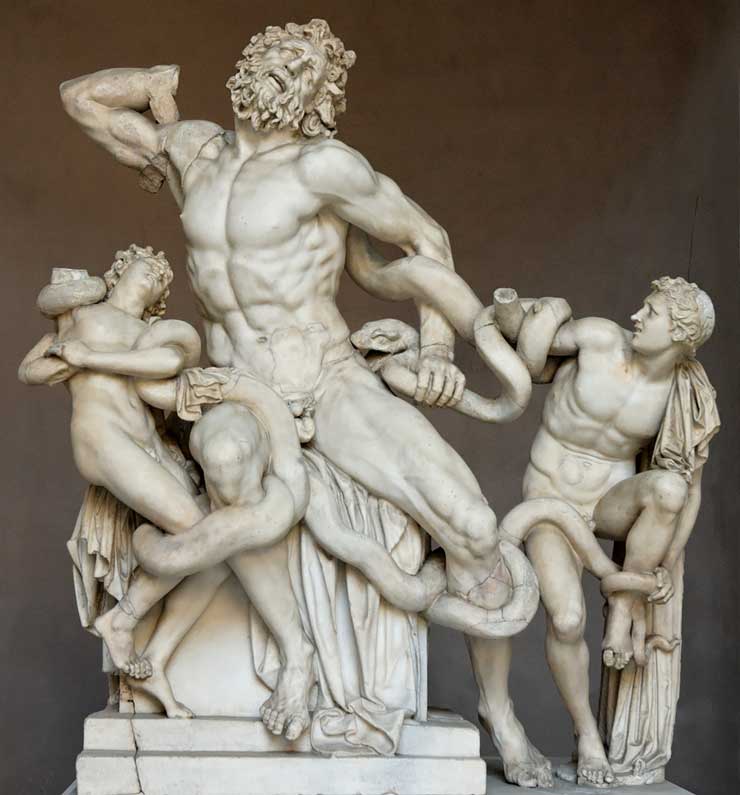.
Φοβού τους Δαναούς και δώρα φέροντες
"Beware of the Danaous (Greeks), bearing gifts"

Musei Vaticani, State of the Vatican City
Artists Agesander, Athenedoros and Polydorus
Laocoön and his sons, also known as the Laocoön Group. Marble, copy after an Hellenistic original from ca. 200 BC.
Dimensions H. 1.84 m (6 ft. ¼ in.)
Credit line Found in the Baths of Trajan, 1506
Accession number Inv.1059, Inv.1064 and Inv. 1067
Location Museo Pio-Clementino, Octagon, Laocoön Hall
Laocoön (Greek Λαοκοων, pronounced roughly La-oh-koh-on), son of Acoetes, was allegedly a priest of Neptune (or of Apollo, by some accounts) at Troy; he is famous for warning the Trojans in vain against accepting the Trojan Horse from the Greeks, and for his subsequent divine execution.
Virgil's Aeneid describes the circumstances of Laocoön's death as follows:
Laocoön warned his fellow Trojans against the wooden horse presented to the city by the Greeks. In the Aeneid, Virgil gives Laocoön the famous line Equo ne credite, Teucri / Quidquid id est, timeo Danaos et dona ferentis, or "Do not trust the Horse, Trojans / Whatever it is, I fear the Greeks even when they bring gifts." This line is the source of the saying: "Beware of Greeks bearing gifts."
The Trojans disregarded his advice, however, and in his resulting anger Laocoön threw his spear at the Horse. Poseidon (some say Athena), who was supporting the Greeks, subsequently sent sea-serpents to strangle Laocoön and his two sons, Antiphantes and Thymbraeus. (Some accounts say Apollo sent the serpents for an unrelated offense, and only unlucky timing caused the Trojans to misinterpret them as punishment for striking the Horse.)
Head of Laocoon, Andrea Appiani
Virgil describes this scene by the lines (original Latin):
Ille simul manibus tendit divellere nodos
perfusus sanie vittas atroque veneno,
clamores simul horrendos ad sidera tollit
qualis mugitus, fugit cum saucius aram
taurus et incertam excussit cervice securim.
Literal English translation:
At the same time as, with his hands, he strives to tear away the knots,
his fillet soaked with slaver and dreadful poison,
he also raises horrifying shrieks to the stars
like a bellowing [bull], when it flees, wounded, from the altar,
bull, and it shakes a badly aimed axe from its neck.
John Dryden's poetic English translation (see [1] (http://www.bartleby.com/13/2.html), line 290):
With both his hands he labors at the knots;
His holy fillets the blue venom blots;
His roaring fills the flitting air around.
Thus, when an ox receives a glancing wound,
He breaks his bands, the fatal altar flies,
And with loud bellowings breaks the yielding skies.
The death of Laocoön is depicted in the monumental statue of Laocoön and his Sons (attributed to Rhodian sculptors Hegesandros, Athenedoros, and Polydoros).
Laocoon and his sons and the aesthetics of pain (including some old and modern versions by other artists)
Laocoon, Alessandro Allori
Laocoon, William Blake
Laocoon, Nicolaus Beatrizet
--------------------------------------------------------------------------------
An unrelated Laocoon, also spelled "Lacoon", son of Porthaon, was one of the Argonauts.
See also : Greek Mythology. Paintings, Drawings
| Ancient Greece
Science, Technology , Medicine , Warfare, , Biographies , Life , Cities/Places/Maps , Arts , Literature , Philosophy ,Olympics, Mythology , History , Images Medieval Greece / Byzantine Empire Science, Technology, Arts, , Warfare , Literature, Biographies, Icons, History Modern Greece Cities, Islands, Regions, Fauna/Flora ,Biographies , History , Warfare, Science/Technology, Literature, Music , Arts , Film/Actors , Sport , Fashion --- |
Retrieved from "http://en.wikipedia.org"
All text is available under the terms of the GNU Free Documentation License





